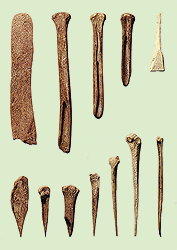 
Among the material remains of Neolithic settlements, an abundance of artifacts of bone and deer antler in a large morphological variety have been unearthed. Bone tools were manufactured from the bones of the rear hind of domesticated animals, mainly sheep and goats, cattle to a lesser extent, while more rarely bones of wild animals and birds were used (e.g. deer). The techniques applied in order to change the natural form of the bones, already in use from Pre-Pottery Neolithic, included fracture, contusion, scraping, grooving, rubbing, polishing and piercing. The functional parts of the bones, that is one or both of their ends, were pointed, linear or rounded. The largest group of bone tools consisted of pointed ones, which were used as awls and needles for working leather, weaving, basketry and pottery decoration. Tools that were pointed at both ends, were probably used as hooks, already in existence from the Mesolithic Period (Cyclops Cave at Yioura), while hooks in their classical form are also encountered. Spatulas for burnishing pottery and cleaning leathers, as well as spindle whorls (weights for the loom) and combs for weaving were also some of the basic types of tools of the Neolithic. Antler tools are mainly manufactured from deer antlers, which were acquired while hunting or collected from antlers shed by animals, in the area of their activity. The discovery of antler tools in settlements remote from the habitats of deer is evidence of the use of deer antlers as an exchange material between communities. The exceptional elasticity and resistance of deer antler was particularly appreciated by Neolithic man who manufactured a plethora of different implements from the material: adzes and handles or hafts for stone knives, drills, awls, chisels, adzes and hammers. The hafting of tools presupposes the partial or complete removal of the spongy material inside the deer antler. |